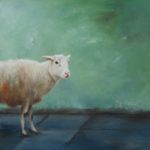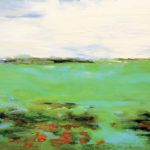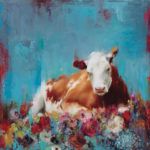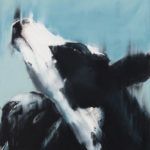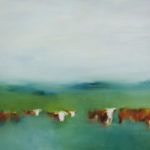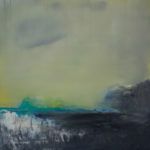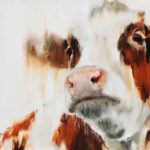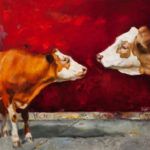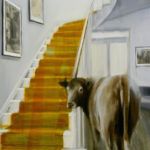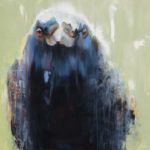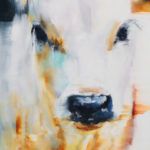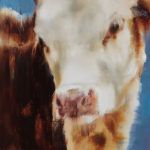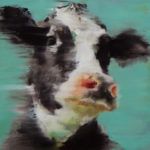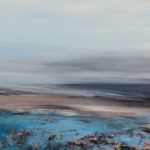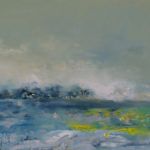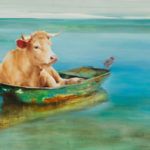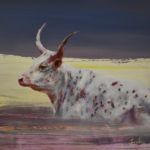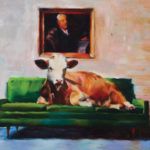Elsa Sroka and the creative instinct
by Elizabeth L. Delaney
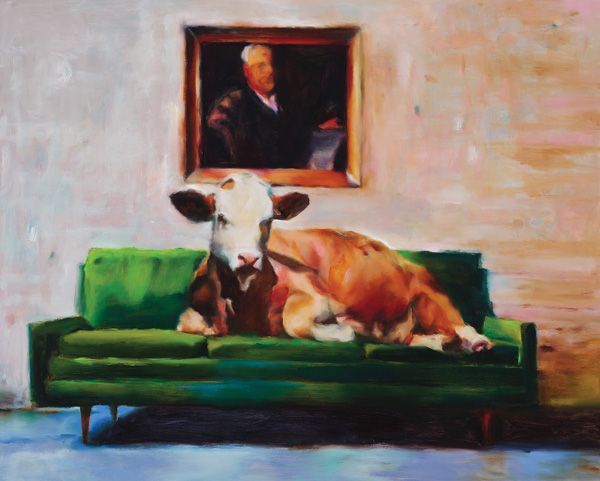
Elsa Sroka, The New Couch, oil, 32 x 40.
This story was featured in the August 2017 issue of Southwest Art magazine. Get the Southwest Art August 2017 print issue or digital download now–then subscribe to Southwest Art and never miss another story.
Denver painter Elsa Sroka places her artwork squarely on the contemporary side of realism. Drawing from her own memories as well as a deep font of imagination, Sroka transforms traditional subject matter into partially abstracted yet lucid expressions of the things that feed her soul. An intense love of color and design, at times infused with her wry wit, forms the foundation of Sroka’s painting. She strives to communicate these facets of her aesthetic and herself to viewers, even as she seeks to fulfill her own drive to create.
Largely self-taught, Sroka hovered on the outskirts of the art world for years. She honed her sense of color by painting rooms in her home over and over until she found just the right hue. She worked on her technique by painting murals in her children’s rooms. And when the time came to evolve, she embraced the change completely, exchanging her day job for her passion. Success came quickly, and she burst onto the commercial gallery scene after little more than a year. Sroka met the challenge head on, and seven years later she has taken her place among the most notable contemporary artists in the West.
A Colorado native, Sroka grew up in a family of six children, all of whom were encouraged by their parents to embrace their creativity. Sroka describes her father as being passionate about art and architecture and having a constant supply of such projects available to keep his children engaged. “Art has always been a huge part of my existence,” says Sroka. Likewise, at school, art class was the only one that truly captivated her.
- Elsa Sroka, All Dressed Up and Nowhere to Go, oil, 20 x 20.
- Elsa Sroka, Floating Cadmium, oil, 8 x 10.
- Elsa Sroka, Flora and Fauna, oil, 25 x 24.
As an adult, Sroka channeled her creativity into styling hair and spent more than two decades in that field. She considers her time as a stylist as informative for her later fine-art career, allowing her to explore color and design techniques daily. “I always imagined people’s hair as sculpture,” she explains. “Working with materials like hair textures that change from person to person, I was making quick decisions as to how to sculpt unique hair types into flattering shapes, as well as find flattering colors for each skin tone.” But dealing with hair exclusively didn’t fully satisfy Sroka’s artistic desires. As she helped organize art auctions at her children’s school and worked with them on their own art projects, she thought more about her own passion for design and aesthetics. Her next move was pivotal: she enrolled in art classes.
Sroka studied at the Art Students League of Denver for nearly a year before she decided to quit styling hair and make the leap to painting full time. “I wanted to make my own mark and express my own voice,” she says of the life-changing move. Painting on her own and at the League proved challenging for the artist, but at the same time, she felt as if she had come home. “I took a few classes that were completely over my head,” she says. “I had no idea of the basics—what paint to bring, what surfaces to paint on—but I also felt so comfortable in that world that it didn’t matter. I felt like I was in a foreign country, surrounded by and immersed in it, and I would naturally pick up what I needed. I also had an intense desire to learn and felt like I was consuming and devouring something that I was starved for. I still feel like that.”
She started off sampling several mediums, from oils to watercolors, and explored a variety of subject matter as well. Eventually, this trial and error led Sroka to her signature cows. While painting a chance portrait of a bovine, she decided she wasn’t happy with the direction the piece was taking. She began scraping the paint off and moving the pigment around, and before long she had transformed the composition into a more abstracted piece that revealed an energy and vibrancy the original image lacked. She incorporated this “accidental” technique into subsequent pieces and found a kinship with the process that soon became integral to her work.
- Elsa Sroka, Madeline, oil, 24 x 18.
- Elsa Sroka, 7 Hiding Cows, oil, 18 x 24.
- Elsa Sroka, At the Edge of the Rock, oil, 24 x 24.
Oddly enough, Sroka’s painting experience was one of her first with cows. What began as random compositional elements developed into objects of sincere affection. “I fell in love with them through painting them,” says the artist of her cows. “It wasn’t because I grew up with them; it wasn’t any deeper connection to them, really. But I love how they have this expressive feel, and I pick out the cows that I feel a connection with.”
A cow on a couch, in a boat, or next to a staircase—these are the clever juxtapositions that situate Sroka’s traditionally bucolic subjects in a decidedly contemporary realm. “Why do cows and cattle always have to be in rural settings? I want them to have a more contemporary twist,” Sroka muses. Her spin on the usual pastoral scenes is evidence of her flair for the unexpected, while also incorporating a bit of whimsy into the work. Further, she treats each cow as its own entity, homing in on its individual characteristics. She believes she has gained a deeper understanding of the cows as a result of this approach and explains, “I feel like I know them. I feel like there’s a connection that I’ve made just in studying their faces and their body language so much.”
In contrast to her thoughtfully constructed cow portraits, Sroka’s painterly, demonstrative landscapes are spontaneous, often based on her reactions to color combinations. “Color is a really big thing for me,” she says. Indeed, many of her paintings are born of nothing more than a swath of color that speaks to her in the moment. She then incorporates other hues that complement her narrative and threads the assorted elements together, often adding glazes to produce cohesion among the layers. What begins as a simple, singular act grows into bold pairings and subtle shifts that swell and recede, producing a distinctive atmospheric depth and intensity.
- Elsa Sroka, Blanca, oil, 24 x 24.
- Elsa Sroka, Heart to Heart, oil, 33 x 49.
- Elsa Sroka, House Guest, oil, 24 x 20.
A combination of her experiences and feelings, Sroka’s freestyle, impasto landscapes offer a counterpoint to her meticulously designed cow paintings. Each process allows her to access a different area of her creativity, and in turn informs and reinforces the other. “I love to have both,” she says of the two methods.
Sroka works in her studio, surrounded by tubes of oil paint, canvases in various stages of completion, and her many tools, among which are an array of brushes, scraping implements, and even her hands. The physical act of creating is paramount for Sroka, and she takes great pleasure in the tactility of her process. The mixing, painting, scraping, and smearing all foster an immediate and lasting connection between artist and work. When arranging compositions, she eschews digital editing programs, preferring to cut out and piece together found digital or magazine photographs by hand so she can visualize each new scene before translating it into paint.
Using digital images allows her to zoom in and capture each animal’s unique facial shape and demeanor. By keeping her compositions small enough to focus on her subjects’ subtleties, she can pepper her canvases with the “little bits” that give viewers a visual foothold. All of this results in carefully executed layers of rich pigment infused with the artist’s thoughts and movements. “It’s a process to me,” she explains. “I’m not afraid to destroy a painting and bring it back.”
- Elsa Sroka, Loretta, oil, 24 x 36.
- Elsa Sroka, Marigold, oil, 10 x 8.
- Elsa Sroka, Mirabelle, oil, 12 x 12.
Sroka has come a long way in a relatively short period of time. Over the past decade, she has forged a new path, finding success and overcoming challenges along the way. “I have much more confidence in color and drawing now,” she says of her artistic evolution. “I also have faith that, when I let things go, I can bring the painting back in a confident way to control it.” Further, Sroka feels that her work with abstract landscapes has freed her to explore subject matter in a looser fashion and to access her intuitive side more fully than before.
Looking forward, she intends to mine that feeling of freedom by exploring additional abstraction. “I love the new inspiration of the florals,” she says of her latest pieces, which strike a balance between the methodical process that fuels her cow paintings and the spontaneity that emerges from her landscapes. “It’s incredible how if you can just not think about the expectation, your work can grow,” she remarks.
For Sroka, making art is engrained in her being. It is an action from which she derives physical, emotional, and intellectual sustenance. “I paint because I need to,” says the artist. “For years I have been searching for something, not always sure what it is. I am driven to pore through design magazines or the Internet, devouring images, colors, shapes, and new ideas. It feels like I am eating, nourishing my soul. Art in one form or another is really the only thing that totally engages me.”
representation
Abend Gallery, Denver, CO; Terzian Galleries, Park City, UT; Eisenhauer Gallery, Edgartown, MA; Sorrel Sky Gallery, Santa Fe, NM.
- Elsa Sroka, Sigmond, oil, 12 x 12.
- Elsa Sroka, Silver Water, oil, 12 x 24.
- Elsa Sroka, Storm at Sea, oil, 7 x 8.
- Elsa Sroka, Sunday Afternoon, oil, 26 x 37.
- Elsa Sroka, Windless, oil, 7 x 8.
- Elsa Sroka, The New Couch, oil, 32 x 40.
This story was featured in the August 2017 issue of Southwest Art magazine. Get the Southwest Art August 2017 print issue or digital download now–then subscribe to Southwest Art and never miss another story.
MORE RESOURCES FOR ART COLLECTORS & ENTHUSIASTS
• Subscribe to Southwest Art magazine
• Learn how to paint & how to draw with downloads, books, videos & more from North Light Shop
• Sign up for your Southwest Art email newsletter & download a FREE ebook






